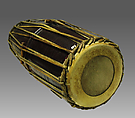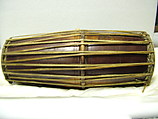Pakhāvaj
Not on view
The pakhāvaj is commonly regarded as the ancestor of the tablā. Its two sides were separated into two separate drums to facilitate tuning and accommodate the performance technique. Before the tablā gained popularity in the late 18th century, the pakhāvaj was the most popular drum for the accompaniment of classical music in North India. It is closely associated with the genre of music called dhrupad and stringed instruments such as the dhrupad rabāb and rudra veena. Black tuning paste on both the pakhāvaj and tablā lowers the pitch of the instruments and gives them a ringing tone.
Due to rights restrictions, this image cannot be enlarged, viewed at full screen, or downloaded.
This artwork is meant to be viewed from right to left. Scroll left to view more.




